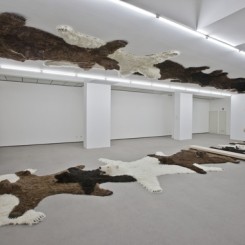“Share But It’s Not Fair,” solo exhibition by Paola Pivi.
Rockbund Art Museum (Rockbund Art Museum, No. 20 Huqiu Road, Shanghai). July 7 – September 9, 2012.
I have been a Paola Pivi fan since 2000, when I first saw “Senza Titolo (Untitled)” at one of the most beautiful museums in Italy, the Castello di Rivoli, on the outskirts of Turin. “Senza Titolo” is an unframed white painting — the one on show at the Rockbund Art Museum is called “Thank You Ocean” — made of thousands of artificial pearls. It is a concentration of power, mass and beauty playfully hovering between flatness and volume, between the pictorial and the sculptural. Despite their physical imprisonment the white pearls burst with intensity, as irrepressible as whitlow grass.
In recent years, Pivi has won increasing international recognition for her ambitious projects, which are often large-scale and complex and which require specialist technical knowledge to realize. “Signatures of The Invisible” (at PS1 Moma, New York), for instance, was developed with scientists at the particle physics laboratory CERN in Geneva. Awarded a Golden Lion at the 1999 Venice Biennale, Pivi’s work has been exhibited internationally, including at the Palais de Tokyo in Paris (2002), at the Museo d’Arte Contemporanea in Rome (2003), at London’s Tate and at the Museum of Contemporary Art in Chicago.
“Share, But It’s Not Fair,” curated by Rockbund Art Museum’s new director Larys Frogier, brings to Shanghai an authoritative selection of the Alaska-based Milanese artist’s works. Emblematic of Pivi’s practice, “It’s a Cocktail Party” is perhaps the most stunning work in the Rockbund show. A spectacular piece initially conceived in 2008 for the Portikus Gallery in Frankfurt, it consists of nine objects made of polished steel, each comprising of a five meter-tall pipe, a pump, and a basin. In each installation, a liquid substance circulates continuously thanks to careful engineering. In the Shanghai installation, the nine fluids that plunge into their respective basins in one thunderous jet are black ink, coffee, red wine, orange juice, glycerine, water, orzata (orgeat syrup) and facial tonic, possibly a recapitulation of Pivi’s (and everybody’s?) daily encounters with liquidity. Watching and hearing these large simulacra of public fountains at work is exhilarating. And I was reminded of the pleasures of free public drinking in my hometown, where such fountains still exist.
Pivi’s projects are not just an inventive restatement of the dialectic between multiplicity and homogeneity; they are also an irreverent spectacularization of the everyday.
The artist’s irreverent neutrality is what distinguishes her works from those of her contemporaries. Her use of live animals or of animal simulacra is a case in point. As a prelude to a previous show she wrote: “On January 18, 2007, a performance with a leopard and 3,000 cappuccino cups took place at the Kunsthalle Basel. The performance was not accessible to the public.” This was the announcement at the entrance to the installation “One Cup of Cappuccino, Then I Go” (2007). Eventually, viewers were met with an array of painted cappuccino cups variously arranged on podia or laid out on the dirt-scattered floor: something had prowled amid this careful setting, upsetting and exposing it. This something was a real live leopard borrowed from a German magician that appeared in all its lustrous elegance in a small documentary photograph at the installation’s distant end.
And yet, Pivi does not ultimately set out to control or harness her viewers’ uneasiness. She is after something else rather more intriguing. In Martin Herbert’s words, she “sets intensities in play and then steps back, trusting the cultural cargo her subjects carry to keep meaningless at bay” (“Tales of the Unexpected,” 2007). In “What Goes Round — Art Comes Round,” also on show at the Rockbund, Pivi presents polar, brown and grizzly bears. This time the animals are neither alive nor real: they are full-size hyper-realistic reproductions of the bear rugs of old. Vistas of North American hunters or North London taxidermists or Northern Italian living rooms are mischievously evoked in this installation of 25 white, brown and black bear rugs laid out in to form a continuous strip of multicolored fur across the walls and ceiling. A low wooden bench traverses the installation and so do the viewers, many of whom are seduced into photographing themselves and thus being “framed,” rolling with Pivi’s fur loop. In this ambiguous spectacle of relinquished authority and control, what or whom is being displayed? Who is looking at what? Or as Pivi asked a few years ago when questioned about the difference between the Milanese and other art scenes, “That is like asking: how is my mother different from other women?”
